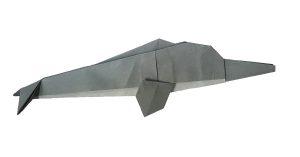
The last ever dolphin message was misinterpreted as a surprisingly sophisticated attempt to do a double-backward somersault through a hoop while whistling the “Star Spangled Banner,” but was, in fact, a message. The message was “so long, and thanks for all the fish”.
Douglas Adams, The Hitchhiker’s Guide to the Galaxy
About the Origami Dolphin
“Dolphins are a hard subject in origami”. So said Marc Kirschenbaum in his Origami Design Primer class at the OrigamiUSA Convention recently. The problem is the dorsal fin. You can’t invent an extra flap on a piece of paper without creating a lot more folds, so it’s not possible to get that dorsal fin and the two fins on the side without having other crease lines on the model that don’t reflect any natural feature of the body of a dolphin. Not without cutting the paper anyway. The challenge is how to achieve that with the minimum disruptive extra folds on the final model.
After playing around and trying to make my own origami Dolphin both during and after the class, I wasn’t very happy with my design – certainly not happy enough to share it on here anyway! I thought I’d take a look at how other designers have dealt with the ‘dorsal fin problem’. I like this model by Hsi-Min Tai. The solution is neat and minimises the number of excess creases on the Dolphin.
The dorsal fin is derived from a pleat along the Dolphin’s body. Most of the paper that forms the side fins is hidden by rearranging the layers inside the body. This leaves only a small vertical crease, and this is is barely noticeable as the lines of the model naturally encourage you to look horizontally along the shape of the Dolphin. Clever.
Folding the Origami Dolphin
It’s basically a distorted fish base. The folds at the end that would normally become the tail do not converge on a single point. Instead, they are separated by a small triangle which becomes the tail. The model is described in the OrigamiUSA Annual Collection as an intermediate level model, I would say this is low intermediate, bordering on simple. The most difficult thing to do for this model is to reverse the direction of the folds that make the side fins and hide the flaps inside the paper, but this is actually very easy to do in practice. Anyone that can fold a classic crane can fold this with ease.
Any paper will do. Ideally, something that is grey or blueish grey since this is supposed to be a dolphin, but there’s no reason why you can’t fold a purple one if you like! I used 24cm x 24cm (9.5in x 9.5in) kami (ordinary origami paper) This produces a final model that is about 24cm long (9.5in) and 6.5cm (2.5in) tall give or take a little bit because some folds are a matter of judgment, without reference points.
The paper I used was provided in the OrigamiUSA Convention Pack, sponsored by Taro’s Origami Studio. I have to say I was quite pleased with this paper, which surprised me because I really don’t like origami paper. It looks dull and lifeless. Also, far too often kami is low quality and the colour is just painted on, so it comes off as soon as you fold it and the final model can be ruined by unsightly white creases. This paper didn’t do that. Well done Taro’s!
This easy origami dolphin model takes about five to ten minutes to fold. If you want to fold a more advanced dolphin there are some nice models in the Red Paper’s Pure Origami book.
Origami Dolphin Instructions
Diagrams showing how to make the origami dolphin are available in the Origami Collection 2016, available to order from OrigamiUSA. This has 54 models in it, covering a range of subjects and aimed at various abilities.
Get Involved
I’d love to hear your views on this origami dolphin. Feel free to let me know what you think in the comments below, or you find can me on Instagram or Twitter. Check out my Pinterest boards too!
Sign up for my origami newsletter here and get our free Origami eBook.
